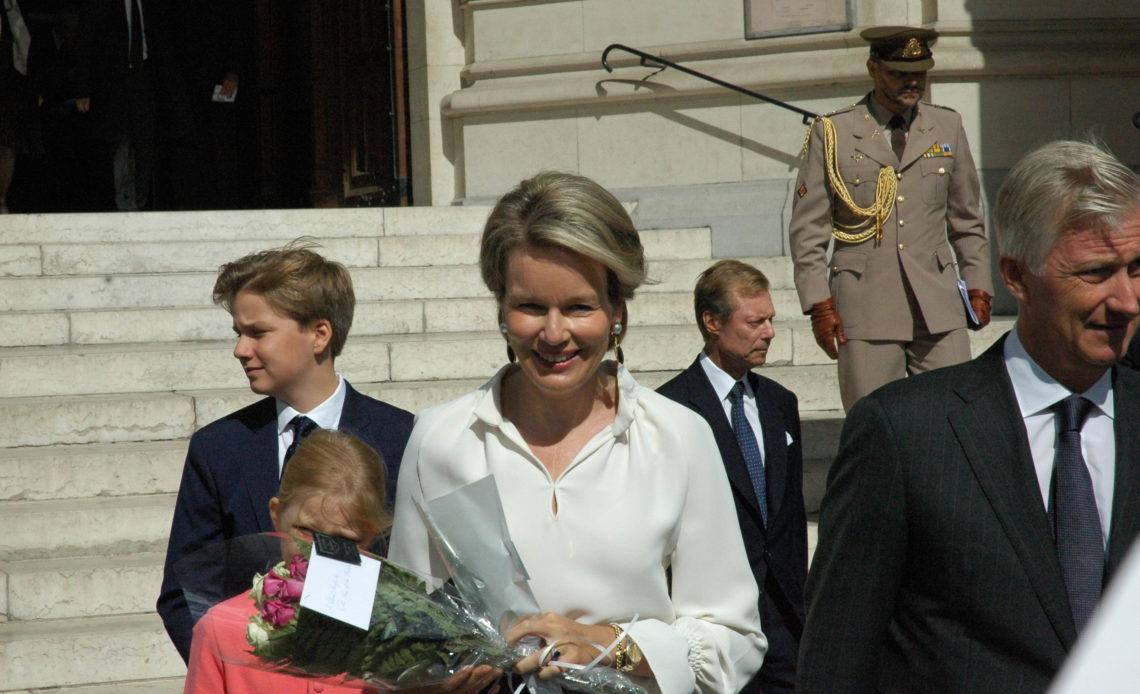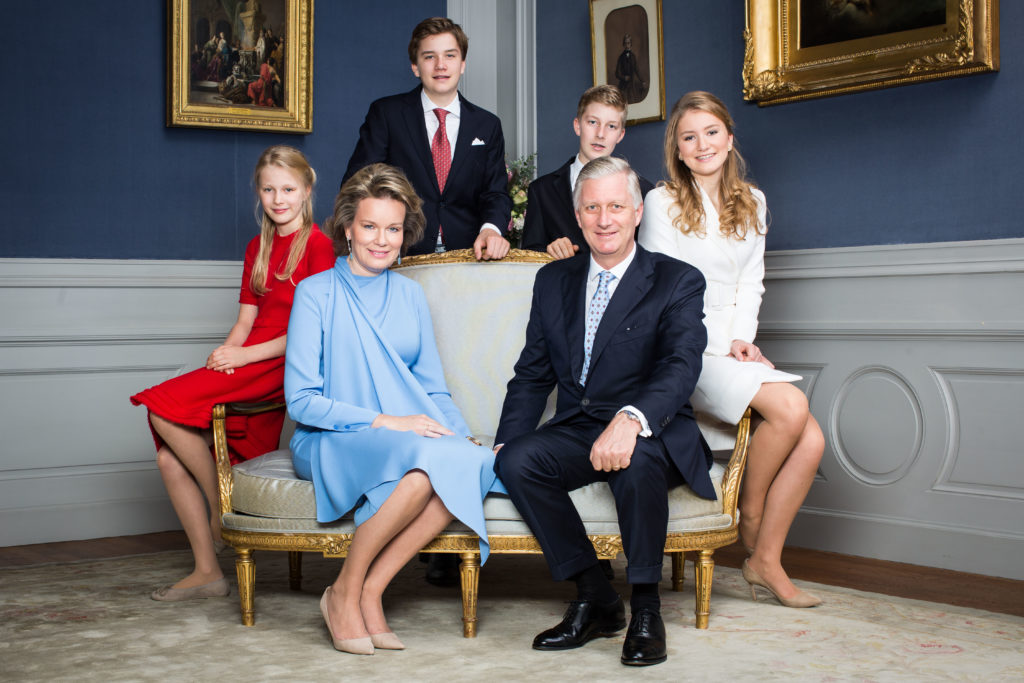
Mathilde Marie Christiane Ghislaine d’Udekem d’Acoz was born on 20 January 1973. She is the oldest child of Jonkheer Patrick d’Udekem d’Acoz and his wife, Countess Anna Maria Komorowska. Through her mother’s paternal family, Mathilde has Polish noble ancestry, as well as Polish–Lithuanian Princely ancestry through her mother’s maternal family. Her maternal grandmother was a Princess of the Polish-Lithuanian Princely House of Sapieha. Mathilde’s father descends from French-speaking, Walloon nobles and was titled Jonkheer, the lowest title within the Belgian nobility system. As a result of this position within the nobility, Mathilde carried the title Jonkvrouw from birth.
The young noble grew up on her family’s estate, Castle Losange in Villers-la-Bonne-Eau in the Bastogne municipality of Belgium, near the Luxembourgish border. Mathilde has four siblings: Jonkvrouw Marie-Alix d’Udekem d’Acoz (1974-1997); Margravine Elisabeth Pallavicini (born in 1977); Baroness Hélène Janssen (born in 1979); and Count Charles-Henri d’Udekem d’Acoz (born 1985). It was in Bastogne that Mathilde attended primary school before attending secondary school at the Institut de la Vierge Fidèle in Brussels, Belgium. This is the same secondary school that Stéphanie, Hereditary Grand Duchess of Luxembourg would later attend during a period of her education.
From 1991-1994, Mathilde attended the Institut Libre Marie Haps in Brussels, where she studied speech therapy and graduated magna cum laude. Following this, Mathilde began studying psychology at the Université Catholique de Louvain and ran her own speech therapy practice in Brussels from 1995 until her marriage in 1999. She continued her studies after her marriage and received a master’s degree in psychology in 2002.
Mathilde met His Royal Highness, Prince Philippe, Duke of Brabant, heir to the Belgian throne, in 1996 while playing tennis. The announcement of the couple’s engagement in September 1999 came as a complete surprise to the country, due to the fact that, unbelievably, their relationship went undetected by the Belgian press.
Embed from Getty ImagesThe pair were married on 4 December 1999, firstly in a civil ceremony held in the Gothic Town Hall of Brussels, before being married religiously in a lavish ceremony at the Cathedral of Saint Michael and Saint Gudula. The bride wore a coat-dress designed by Édouard Vermeulen of the Belgian Fashion House Natan. The simple, satin dress was covered by a satin coat which featured a long, heavy train. The bride topped off her ensemble with a lace, antique veil loaned to her by her new mother-in-law, Queen Paola of the Belgians. The Queen wore the veil on her own wedding day to the (then) Prince of Liège in 1959. This was anchored by a diadem formally belonging to the groom’s grandmother, Queen Astrid of Belgium, loaned to Mathilde for the occasion by the King and Queen.
There were several royal representatives in attendance at the religious service, including Queen Fabiola of Belgium, Grand Duke Jean and Grand Duchess Joséphine-Charlotte of Luxembourg; Hereditary Grand Duke Henri and Hereditary Grand Duchess Maria Teresa of Luxembourg; Queen Beatrix of the Netherlands; Queen Margrethe II and Prince Henrik of Denmark; King Harald and Queen Sonja of Norway; King Carl XVI Gustav and Queen Silvia of Sweden; Queen Sofía of Spain; Charles, Prince of Wales; and Crown Prince Naruhito and Crown Princess Masako of Japan. Upon her marriage, Mathilde received the title Princess of Belgium in her own right, and Duchess of Brabant as the consort of her husband, with the style of Royal Highness.
Following their marriage, the princely couple moved into the Palace of Laeken in Brussels, where Prince Philippe had already been living. This property is usually always the home of the sovereign, however, upon his accession to the throne following the death of his brother King Baudouin, King Albert II preferred to remain at Belvedere Castle, where he had been living with Queen Paola since their 1959 marriage. The couple has four children: Princess Elisabeth (born on 25 October 2001), Prince Gabriel (born on 20 August 2003), Prince Emmanuel (born on 4 October 2005) and Princess Éleonore (born on 16 April 2008). Due to a change in the Act of Succession in 1991, Princess Elisabeth will become the first Belgian Queen Regnant upon the death or abdication of her father. Mathilde attaches great importance to her family.
In 2001, the Duchess of Brabant set up the Princess Mathilde Fund, which promotes the care of vulnerable people and awards an annual prize for good works in a particular sector. The sector changes each year: examples include early years education, women’s health, and protecting young people from violence. Her Royal Highness also presided and continues to preside at the ceremony awarding the King Baudouin International Development Prize.
In 2013, upon the abdication of King Albert II, Prince Philippe, Duke of Brabant acceded to the throne as the seventh King of the Belgians, thus making Mathilde the first Queen of the Belgians to have been born in Belgium and the only member of the nobility (though not royalty) by birth among the current queens consort of Europe. Upon their accession, the sovereign couple’s eldest daughter, Princess Elisabeth received the title of Duchess of Brabant in her own right, as future Queen Regnant of Belgium.
Embed from Getty ImagesAs Queen of the Belgians, Mathilde carries out a number of official roles, including representing Belgium on state visits, receiving state visits from abroad, and as the patron of many charities. Since 2007, the Queen has been a member of the Young Global Leaders group. In the company of King Philippe, Her Majesty has led economic missions to the USA in 2011 and Vietnam in 2012. Since 2009, the Queen has been the Honorary President of UNICEF Belgium. She serves as the World Health Organisation’s Special Representative for Immunisation.
Apart from her activities in the company of the King, Queen Mathilde also devotes time to issues that are close to her heart. She regularly visits social institutions and medical centres. These contacts help her to stay in touch with the people and their needs and requirements and also to stay in touch with the many initiatives undertaken in Belgium to help others. The Queen attaches a great deal of importance to keeping close contact with the population. The Queen is Honorary President of Child Focus and the Foundation for Missing and Sexually Exploited Children. Children’s well-being is a fundamental principle for Her Majesty, and she dedicates herself in the fight against abduction and all forms of sexual abuse.
The Queen is a member of the Schwab Foundation Board for Social Entrepreneurship. She was a United Nations Emissary for the International Year of Microcredit 2005, which focused in particular on financial inclusion and financial literacy. Queen Mathilde also attends the annual World Economic Forum in Davos. Belgian development cooperation is an important issue for the Queen. Her Majesty has undertaken a number of humanitarian missions (mainly in Africa), highlighting areas such as children’s rights, health issues, poverty reduction, education, good governance, the empowerment of women, HIV/AIDS and orphans (UNICEF/UNAIDS), and non-communicable diseases.
In her spare time, Mathilde enjoys reading, listening to modern and classical music, and playing the piano. As of 2014, the Queen has given her high patronage to the International Queen Elisabeth Music Competition (previously under the patronage of Queen Fabiola), founded in 1937 as an initiative of Her Majesty Dowager Queen Elisabeth of Belgium and Belgian composer and violist Eugène Ysaÿe.

Queen Mathilde is a big fan of sports and is reported to be a good tennis player and swimmer. Her Majesty enjoys nature and open-air activities. Aside from French, which is the Queen’s mother-tongue, Her Majesty is also fluent in Dutch, English and Italian and has basic knowledge in Spanish. Her mother (who spent most of her life outside of Poland) did not teach her Polish, thinking that it would not be necessary. Therefore, Queen Mathilde knows only a few words in the language.

